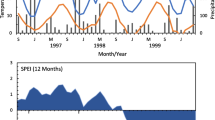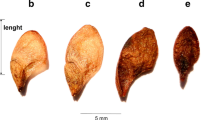Abstract
The objective of this study was to analyse quantitatively the spatial distribution of holly (Ilex aquifolium L.) seed rain and seed bank, and to detect the relationships between these consecutive processes. We measured seed dispersal by birds and fallen fruits, and also density and viability of seed bank in two Ilex populations in central Spain. Analysis was made distinguishing the following microhabitats: holly woodland, edge of holly woodland, open grassland 10 m and 100 m from the woodland, fleshy fruit shrubs, dry fruit shrubs, and adjacent non-holly woodland. Spatial distribution of dispersed and in-soil seeds was measured by the clumping index. Seed rain and seed bank under holly woodlands were significantly higher than in the other microhabitats. Forest edges and fleshy fruit shrubs were the next microhabitats with the highest seed rain and seed bank density. Interannual and interlocality variations were not significant. The relative importance of the different dispersal methods varied between microhabitats, with a similar support of bird dispersed seeds and fallen fruits within the woodland and a greater influence of cattle dispersal in open areas. Seed spatial aggregation was significant in both dispersed seeds and soil seeds from holly woodlands and the edge of the forest. Aggregation under shrubs, grasslands and the adjacent forests evidenced a general random distribution of holly seeds (only in some cases clumping index was significant). Quantitative differences between seed rain and seed bank are important. Post-dispersal seed predation did not modify seed rain distribution, which was mirrored in the seed bank pattern. These two phases of holly regeneration had a heavy spatial influence, determined by the landscape structure and activity of the dispersal agents, that reflects a differential recruitment potential. Comparisons between both populations suggest that in the southern locality (Robregordo) holly has a weaker capacity to colonize open areas, and a stronger recruitment limitation due to propagule availability.
Similar content being viewed by others
References
J.M. Alcántara P.M. Rey F. Valera A.M. Sánchez-LaFuente (2000) ArticleTitleFactors shaping the seedfall pattern of a bird-dispersed plant Ecology 81 1937–1950
S. Arrieta (2002) Dinámica de la regeneración de las acebedas (Ilex aquifolium L ) en el centro peninsular. PhD thesis. Universidad Autónoma de Madrid Madrid, Spain
S. Arrieta F. Suárez (1998) Spatial aggregation of bird dispersed seeds in function of scale and microhabitats A comparision of indices of dispersion applied to the case of Ilex aquifolium. Alcalá 1st International Conference on Mathematical Ecology Alcalá de Henares Spain
S. Arrieta F. Suárez (2001” letter=”a) ArticleTitleSeedling diversity and spatially related regeneration dynamics in holly woodlands and surrounding habitats Web Ecology 2 38–46
S. Arrieta F. Suárez (2001” letter=”b) Dispersión endozoócora de las semillas de acebo (Ilex aquifolium L.) por el ganado vacuno: importancia cuantitativa y espacial CIBIO (Centro Iberoamericano de la Biodiversidad), Biodiversidad en pastos SEEP-CIBIO Alicante, Portugal 135–140
S. Arrieta F. Suárez (2003) La regeneración del acebo (Ilex aquifolium L.) en dos poblaciones marginales en su límite meridional de distribución AEET, Actas del VII Congreso Nacional de la Asociación Española de Ecología Terrestre Barcelona Spain
S. Arrieta F. Suárez (2004) ArticleTitleGermination and seed bank depletion of holly (Ilex aquifolium L.) in four microhabitat types Seed Science Research 14 305–313
Castroviejo J. 1975. El Urogallo en España. Nuevas Gráficas, S.A. Estación Biolo’ gica de Doñana. Sevilla, Spain.
Costa M., Morla C. and Sainz H. (eds) 1997. Los bosques Ibéricos. Una interpretación geobotánica. Planeta. Barcelona, Spain.
R.S. Duncan C.A. Chapman (1999) ArticleTitleSeed dispersal and potential forest succession in abandoned agriculture in tropical Africa Ecological Applications 9 998–1008
J.M. Elliot (1983) Some methods for the statistical analysis of samples of bentic invertebrates Freshwater biological association Scientific publications Ambleside, UK
O. Eriksson J. Ehrlén (1992) ArticleTitleSeed and microsite limitation of recruitment plant populations Oecologia 91 360–364
M. Fuentes (1991) ArticleTitleLa producción de frutos carnosos en dos espinales del Noroeste de España Anales del Jardín Botánico de Madrid 49 83–93
M.D. García (2001) Aprovechamiento sostenible de las acebedas del Sistema Ibérico Norte: Caracterización, CrecimientoPropagación, Conservación, Tratamientos Selvícolas y Producción de ramilla con fines Ornamentales Universidad Politécnica de Madrid Madrid
P. García-Fayos M. Verdú (1998) ArticleTitleSoil seed bank, factors controlling germination and establishment of a Mediterranean shrub: Pistacia lentiscus L Acta Oecologica 19 357–366
J. Guitián (1984) ArticleTitleSobre la importancia del acebo (Ilex aquifolium L.) en la ecologia de la comunidad invernal de paseriformes en la Cordillera Cantábrica Occiental Ardeola 30 65–76
J. Guitián (1989) ArticleTitleConsumo de frutos de acebo (Ilex aquifolium L.) y movilizaciones de semillas por paseriformes en las montañas cantábricas occidentales, Noroeste de España Ardeola 36 73–82
J.L. Harper (1977) Population biology of plants Academic Press New York, USA
H.T. Hartmann D.E. Kester (1975) Plant Propagation Principles and Practices. Prentice-Hall New Jersey, USA
G.A.F. Hendry J.P. Grime (1993) Methods in comparative plant ecology Chapman and Hall London, UK
C.M. Herrera (1987) ArticleTitleVertebrate-dispersed plants of the Iberian Peninsula: A study of fruit characteristics Ecological Monographs 57 305–331
C.M. Herrera (1995) ArticleTitlePlant-vertebrate seed dispersal systems in the Mediterranean: ecological, evolutionary, and historical determinants Annual Review of Ecology and Systematics 26 705–727
C.M. Herrera (2001) Dispersión de semillas por animales en el Mediterráneo: ecología y evolución R. Zamora F.I. Pugnaire (Eds) Ecosistemas mediterráneos Análisis funcional. C.S.I.C.-A.E.E.T Spain 125–152
C.M. Herrera P. Jordano (1981) ArticleTitlePrunus mahalebbirds: the high efficiency seed dispersal system of a temperate fruiting tree Ecological Monographs 57 305–331
N. Hewitt M. Kellman (2002) ArticleTitleTree seed dispersal among forest fragments: II Dispersal abilities and biogeographical controls. Journal of Biogeography 29 351–363
K.D. Holl (2002) ArticleTitleEffect of shrub on tree seedling establishment in an abandoned tropical pasture Journal of Ecology 90 179–187
K.D. Holl M.E. Loik E.H.V. Lin I.A. Samuels (2000) ArticleTitleTropical montane forest restoration in Costa Rica: overcoming barriers to dispersal and establishment Restoration Ecology 8 339–349
W.G. Hoppes (1988) ArticleTitleSeedfall pattern of several species of bird-dispersed plants in an Illinois woodland Ecology 69 320–329
G. Houle (1995) ArticleTitleSeed dispersal and seedling recruitment: the missing link(s) Ecoscience 2 238–244
P.E. Hulme (1994) ArticleTitlePost-dispersal seed predation in grassland: its magnitude and sources of variation Journal of Ecology 82 645–652
P.E. Hulme (1996) ArticleTitleNatural regeneration of yew (Taxus baccata L): Micrositeseed or herbivore limitation? Journal of Ecology 84 853–861
P.E. Hulme P. Hunt (1999) ArticleTitleRodents post-dispersal seed predation in dioecious woodland: predator response to absolute and relative abundance of prey Journal of Animal Ecology 68 417–428
Iglesias P. 1999. Oncala ayer y hoy. Excma. Diputación Provincial de Soria. Soria, Spain.
P. Jordano C.M. Herrera (1995) ArticleTitleShuffling the offspring: Uncoupling and spatial discordance of multiple stages in vertebrate seed dispersal Ecoscience 2 230–237
E. Jordano P. and Schupp (2000) ArticleTitleSeed disperser effectiveness: the quantity component and patterns of seed rain for Prunus mahaleb Ecological Monographs 70 591–615
R.K. Kobe S.W. Pacala J.A. Silander (1995) ArticleTitleJuvenile tree survivorship as a component of shade tolerance Ecological Applications 5 517–532
J. Kollmann (1995) ArticleTitleRegeneration window for fleshy-fruited plants during scrub development on abandoned grassland Ecoscience 2 213–222
J. Kollmann (2000) ArticleTitleDispersal of fleshy-fruited species: a matter of spatial scale? Perspectives in Plant Ecology, Evolution and Systematics 3 29–51
J. Kollmann M. Buschord (2002) ArticleTitleEdges effects on seed predation by rodents in deciduous forest of northern Switzerland Plant Ecology 164 249–261
J. Kollmann B. Schneider (1999) ArticleTitleLandscape structure and diversity of fleshy-fruited species at forest edges Plant Ecology 144 34–48
J. Kollmann D.A. Coomes S.M. White (1998) ArticleTitleConsistencies in post-dispersal seed predation of temperate fleshy-fruited species among seasons, years and sites Functional Ecology 12 683–690
M.J. Mc Donnell (1986) ArticleTitleOld field vegetation height and the dispersal pattern of bird-disseminated woody plants Bulletin of the Torrey Botannical Club 113 6–11
M.J. Mc Donell E.W. Stiles (1983) ArticleTitleThe structural complexity of old field vegetation and the recruitment of bird-dispersed plant species Oecologia 56 109–116
R.P. Moore (1987) Manual de ensayos del tetrazolio M.A.P.A. Madrid, Spain
C. Murcia (1995) ArticleTitleEdge effects in fragmented forests: implications for conservation TREE 10 58–62
T. Nakashizuka S. Iida T. Masajum M. Shibata H. Tanaka (1995) ArticleTitleEvaluating increased fitness through dispersal: A comparative study on tree populations in a temperate forestJapan Ecoscience 2 245–251
J.R. Obeso (1998) ArticleTitlePatterns of variation in Ilex aquifolium fruit traits related to fruit consumption by birds and seed predation by rodents Ecoscience 5 463–469
J.R. Obeso I.C. Fernández-Calvo (2003) ArticleTitleFruit removal, pyrene dispersal, post-dispersal predation and seedling establishment of a bird-dispersed tree Plant Ecology 165 223–233
J.A. Oria de Rueda (1992) ArticleTitleLas acebedas de Castilla y León y La RiojaOrigen, composición y dinámica Ecología 6 79–91
G.F. Peterken (1966) ArticleTitleMortality of holly (Ilex aquifolium) seedlings in relation to natural regeneration in the New Forest Journal of Ecology 54 259–269
G.F. Peterken S. Lloyd (1967) ArticleTitleBiological flora of the British Isles Ilex aquifolium L Journal of Ecology 55 841–858
S.T.A. Pickett M.J. Mc Donnell (1989) Seed bank dynamics in temperate deciduous forest M.A. Leck V.T. Parker R.L. Simpson (Eds) Ecology of soil seed banks Academic Press San DiegoUSA 123–147
M.V. Price S.H. Jenkins (1986) Rodents as seed consumers and dispersers D. Murray (Eds) Seed dispersal Academic Press Australiap 191–235
D.W. Purves R. Law (2002) ArticleTitleFine-scale spatial structure in a grassland community: quantifying the plant’s – eye view Journal of Ecology 90 121–129
J. Retana J.M. Espelta M. Gracia M. Riba (1999) Seedling recruitment F. Roda J. Retana C.A. Gracia J. Bellot (Eds) Ecology of Mediterranean Evergreen Oak Forests Springer-Verlag Berlin, Germany 89–103
P.J. Rey J.M. Alcantara (2000) ArticleTitleRecruitment dynamics of a fleshy-fruited plant (Olea europaea): connecting patterns of seed dispersal to seedling establishment Journal of Ecology 88 622–633
Ridley H.N. 1930. The dispersal of plants throughout the world. Otto Koeltz Science Publishers – Bishen Singh Mahendra Pal Singh.
G.R. Robinson S.N. Handel (1993) ArticleTitleForest restoration on a closed landfill: rapid addition of new species by bird dispersal Conservation Biology 7 271–278
J.L. Santos T. and Tellería (1994) ArticleTitleInfluence of forest fragmentation on seed consumption and dispersal of spanish juniper Juniperus thurifera Biological Conservation 70 129–134
T. Santos J.L. Tellería E. Virgós (1999) ArticleTitleDispersal of Spanish juniper Juniperus thurifera by birds and mammals in a fragmented landscape Ecography 22 193–204
E.W. Schupp (1995) ArticleTitleSeed-seedling conflicts, habitat choiceand patterns of plant recruitment American Journal of Botany 82 399–409
E.W. Schupp M. Fuentes (1995) ArticleTitleSpatial patterns of seed dispersal and the unification of plant population ecology Ecoscience 2 267–275
Schupp E.W., Chambers J.C., Vander Wall S.B., Gómez J.M. and Fuentes M. 1999. Piñon and juniper seed dispersal and seedling recruitment at woodland ecotones. USDA Forest Service Proceedings: Shrubland Ecotones. RMRS-GTS.
M.G. Slocum (2001) ArticleTitleHow tree species differ as recruitment foci in a tropical pasture Ecology 82 2547–2559
B. Snow D. Snow (1988) Birds and Berries T and AD POYSER London, UK
A.E. Sorensen (1981) ArticleTitleInteractions between birds and fruits in a temperate woodland Oecologia 50 442–450
InstitutionalAuthorNameStatSoft (1984) STATISTICA for Windows Stat Soft Inc. TulsaOklahomaUSA
J.N. Thompson M.F. Willson (1978) ArticleTitleDisturbance and the dispersal of fleshy fruits Science 200 1161–1163
K. Thompson (1992) The functional ecology of seed banks M. Fenner (Eds) Seeds, The ecology of regeneration in plant communities CAB International Oxon UK 231–258
K. Thompson J. Bakker R. Bekker (1997) The soil seed banks of North West Europe: methodology, density and longevity Cambridge University Press CambridgeUK
K. Thompson R.M. Ceriani J.P. Bakker R.M. Bekker (2003) ArticleTitleAre seed dormancy and persistence in soil related? Seed Science Research 13 97–100
P.A. Williams B.J. Karl P. Bannister W.G. Lee (2000) ArticleTitleSmall mammals as potential seed dispersers in New Zealand Austral Ecology 25 523–532
J.H. Zar (1996) Biostatistical Analysis Prentice-Hall New Jersey, USA
Author information
Authors and Affiliations
Corresponding author
Rights and permissions
About this article
Cite this article
Arrieta, S., Suárez, F. Spatial dynamics of Ilex aquifolium populations seed dispersal and seed bank: understanding the first steps of regeneration. Plant Ecol 177, 237–248 (2005). https://doi.org/10.1007/s11258-005-2186-y
Received:
Accepted:
Issue Date:
DOI: https://doi.org/10.1007/s11258-005-2186-y




